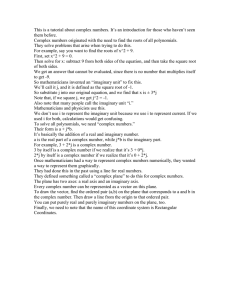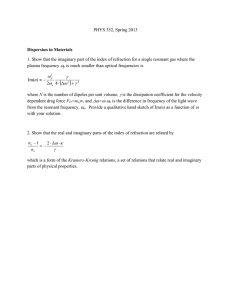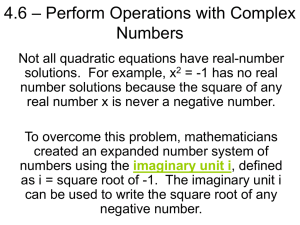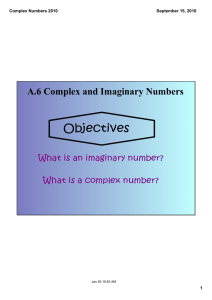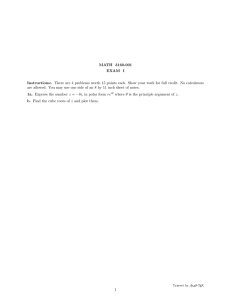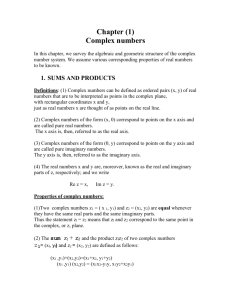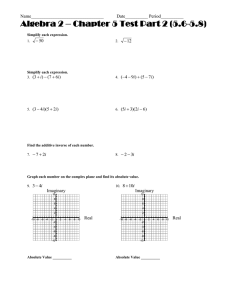The Plane of Complex Numbers
advertisement
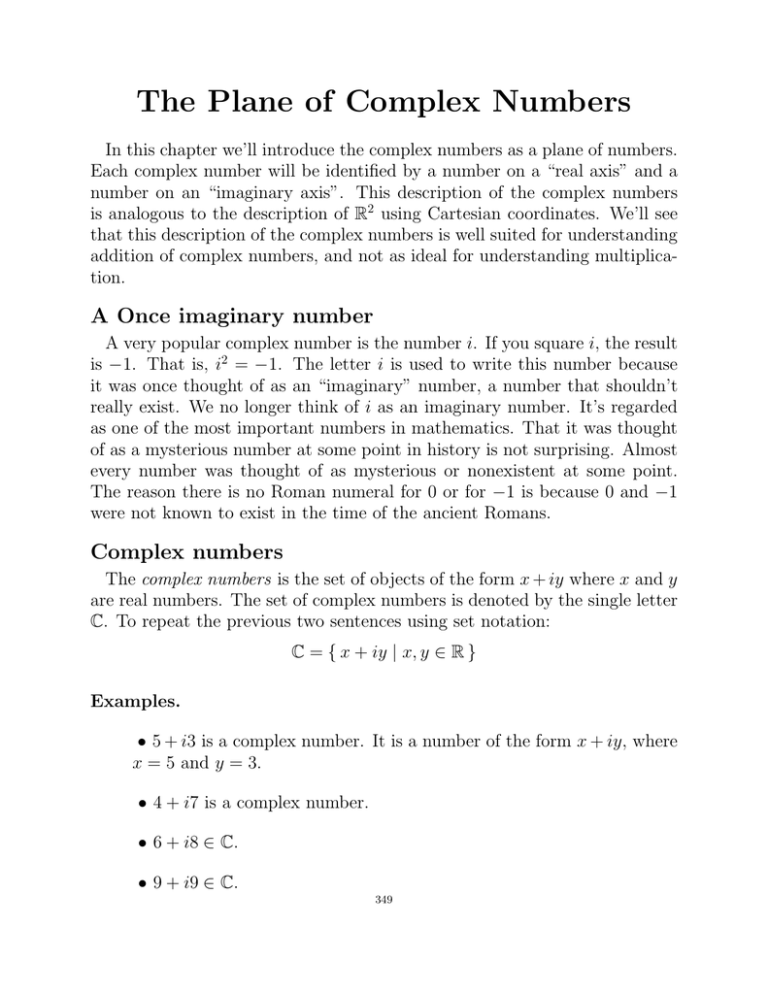
The Plane of Complex Numbers
In this chapter we’ll introduce the complex numbers as a plane of numbers.
Each complex number will be identified by a number on a “real axis” and a
number on an “imaginary axis”. This description of the complex numbers
is analogous to the description of R2 using Cartesian coordinates. We’ll see
that this description of the complex numbers is well suited for understanding
addition of complex numbers, and not as ideal for understanding multiplication.
A Once imaginary number
A very popular complex number is the number i. If you square i, the result
is 1. That is, i2 = 1. The letter i is used to write this number because
it was once thought of as an “imaginary” number, a number that shouldn’t
really exist. We no longer think of i as an imaginary number. It’s regarded
as one of the most important numbers in mathematics. That it was thought
of as a mysterious number at some point in history is not surprising. Almost
every number was thought of as mysterious or nonexistent at some point.
The reason there is no Roman numeral for 0 or for 1 is because 0 and 1
were not known to exist in the time of the ancient Romans.
Complex numbers
The complex numbers is the set of objects of the form x + iy where x and y
are real numbers. The set of complex numbers is denoted by the single letter
C. To repeat the previous two sentences using set notation:
C = { x + iy | x, y 2 R }
Examples.
• 5 + i3 is a complex number. It is a number of the form x + iy, where
x = 5 and y = 3.
• 4 + i7 is a complex number.
• 6 + i8 2 C.
• 9 + i9 2 C.
349
Any complex number is identified by two coordinates of real numbers. For
example, the complex number 5 + i3 is identified by the two real numbers 5
and 3.
If x + iy is a complex number, then we’ll call x the real part of x + iy. The
real number y is the imaginary part of x + iy.
Examples.
• The real part of the complex number 2 + i4 is 2. The imaginary part
is 4.
• 9 + i2 2 C has real part 9 and imaginary part 2.
For two complex numbers to be equal, both their real parts and their imaginary parts must be equal.
Examples.
• 7 + i4 = 7 + i4
• 7 + i4 6= 4 + i7
• 7 + i4 6= 3 + i4
• 7 + i4 6= 7 + i5
There is a simpler way that we often write some complex numbers, as the
examples below illustrate.
Examples.
• Complex numbers of the form x + i0 are usually just written as x.
For example, we would write 3 instead of 3 + i0, and 7 instead of
7 + i0.
• Complex numbers of the form 0 + iy are usually written as iy, For
example, 0 + i4 is written as i4, and 0 + i9 is the same number as i9.
• If the imaginary part of a complex number is negative, then we
usually write the minus sign in front of the letter i. For example, we
write 3 i5 instead of 3 + i( 5), and the complex number 2 + i( 6)
is usually written as 2 i6.
350
• The number i is the preferred way of writing the complex number
0 + i(1).
• 0 + i( 1) is written as
i.
• The complex number 0 + i0 is called the complex number zero. We
write it simply as 0.
Real numbers
Any real number is a complex p
number.pIf x 2 R, then x = x + i0 2 C. For
example, 1 = 1 + i0 2 C and
2=
2 + i0 2 C. This means that the
set of real numbers is a subset of the set of complex numbers. It’s the set of
complex numbers whose imaginary parts equal 0. To repeat, R ✓ C.
While the real numbers are a subset of the complex numbers, there are very
many complex numbers that are not real numbers. Any complex number of
the form x + iy where y 6= 0 is not a real number. For example, 2 + i3 and
i = 0 + i(1) are not real numbers.
Imaginary numbers
An imaginary number is any complex number whose real part equals 0.
That is, an imaginary number is a complex number of the form 0 + iy. For
example, i3 is an imaginary number. So is i6 = i( 6).
The only imaginary number that is also a real number is the number 0.
Both the real part and the imaginary part of 0 are 0.
The Complex numbers are a plane
Because each complex number is identified by a pair of real number
coordinates—its real part and its imaginary part—C is drawn as a plane. We
draw the plane C much as we draw the plane R2 . There is a horizontal axis
that looks like the line of real numbers, and there is a vertical axis that looks
like the line of real numbers turned on its side. When we had looked at R2
we had called the horizontal and vertical axes the x- and y-axes respectively.
When we draw C, we call the horizontal axis the real axis. It’s made up of
the set of real numbers, which is a subset of C. We call the vertical axis the
imaginary axis. It’s made up of the set of imaginary numbers, which is also
a subset of C.
351
+
•
B
•
I
B
a.
N
0
III
3
I
B
‘
A
th°
Any complex number is the sum of a real number and an imaginary number.
In the picture above, the number 2+i3 is drawn as a point in C. Its horizontal
position is determined by its real part, 2. Its vertical position is determined
by the imaginary number i3.
*
*
*
*
*
*
*
*
*
*
*
*
*
Addition
You can add two complex numbers in essentially the same way that you
can add two vectors. Just add their coordinates, their real parts and their
imaginary parts.
Examples.
• The sum of the complex numbers 3 + i5 and 2 + i3 is the number
[3 + i5] + [2 + i3] = (3 + 2) + i(5 + 3)
= 5 + i8
• The sum of the complex numbers 1
[1
i2 and 4 + i is the number
i2] + [4 + i] = (1 + 4) + i( 2 + 1)
=5 i
• The sum of a real number x and an imaginary number iy is x + iy.
352
(i , z)
Geometry of addition
Addition in the plane of complex numbers works essentially the same way
as addition in the plane of vectors does. For example, addition by 1 + i2
would add 1 to the real part of every complex number, and it would add 2 to
theAdding
imaginary
1 + vector
i2 would
complex
numbers
to the
the part.
vectorAddition
(1, 2) to by
every
in shift
the plane,
which
is what
the
right
by
1
and
up
by
2.
function A
does, has the e↵ect of moving every point in the plane to the
(1,2)
+
¶.,
a
•
:
ç•
Iz-i71?
I
•
B
1i2
.fr
Subtraction
2—i7
3
B
‘
I
75
A
th°
B
a.
N
0
C-’
III
right one unit and up two units.
I’
We subtract two complex
numbers by subtracting their real parts and sub4 ‘z. c’
tracting their imaginary parts.
Examples.
<
• The di↵erence of
[ 3 + i2]
cL
[3 + i5]
v
• The di↵erence of 3 + i5 and 2 + i3 is
[2 + i3] = (3 2) + i(5
= 1 + i2
3)
1)
3 + i2 and 4 + i5 is
[4 + i5] = ( 3 4) + i(2
= 7 i3
353
5)
Lf
Norms
The norm of a complex number is very similar to the norm of a vector. It’s
the distance between the complex number and the number 0. The only difference between the norm of a vector in the plane and the norm of a complex
number is that the norm of a vector is indicated by surrounding a vector with
double vertical lines—such as ||(2, 3)||—whereas norms of complex numbers
are indicated by surrounding the number with single vertical lines—exactly
as we do when we write the absolute value of a real number, such as |5|.
Otherwise, norms of vectors in the plane and norms of complex numbers are
determined in the same way. Namely, the norm of a complex number x + iy
is
p
|x + iy| = x2 + y 2
Example.
• |2
i7| =
p
22 + ( 7)2 =
p
4 + 49 =
p
53
a
Iz-i71?
-
2—i7
1i2
Any real number is a complex number. The norm of the complex (and
real) number x = x + i0 is exactly the same as the absolute value of the real
number x. The number |x| is the distance between x and 0.
Example.
•|
3 + i0| =
*
*
*
p
p
( 3)2 + 02 = 9 = 3 = |
*
*
*
*
354
*
*
3|
*
*
*
*
Multiplication
Writing complex numbers using Cartesian coordinates—in the form x+iy—
is not as well suited for multiplication as it is for addition, and it’s even worse
for division. We can say something about it though.
To multiply two complex numbers, just treat the number i as a variable,
and multiply using the distributive law. Then use the rule that i2 = 1 to
write the answer in the form x + iy.
Examples.
• Using the distributive law, and treating i as a variable, we see that
the product of the complex numbers 2 + i3 and 4 + i2 is
(2 + i3)(4 + i2) = 2(4) + 2(i2) + i3(4) + i3(i2)
= 8 + i16 + i2 6
Now using the rule that i2 =
1, we have that
(2 + i3)(4 + i2) = 8 + i16
= 2 + i16
• (3 + i4)(2 + i5) = 6 + i23 + i2 20 =
6
14 + i23
Geometry of multiplication
The two examples above describe how to multiply any pair of complex
numbers, but they don’t give much insight into what it looks like to multiply every number in the complex plane simultaneously by a single complex
number. For example, we know that adding the number 1 + i2 shifts every
complex number to the right 1 and up 2, but it’s not clear at this point how
to describe the transformation of the plane of complex numbers that occurs
when we multiply by 1 + i2.
It turns out that multiplication and division of complex numbers are better
understood using polar coordinates for complex numbers. That will be the
topic of the next chapter.
355
Multiplicative inverse
The multiplicative inverse of x + iy 2 C, as long as x + iy 6= 0, is given by
the formula
1
x
y
= 2
i
x + iy
x + y2
x2 + y 2
Example.
• The multiplicative inverse of 2 + i3 is
1
2
3
2
= 2
i
=
2 + i3 2 + 32
22 + 32
13
i
3
13
Division
To divide two complex numbers, as long as the denominator does not equal
0, first find the multiplicative inverse of the denominator, and then multiply.
Example.
• To find the quotient 5+i7
2+i3 , first find
2
3
previous example equals 13
i 13
. Then
1
2+i3 ,
which we know from the
⇣ 1 ⌘
5 + i7
= (5 + i7)
2 + i3
2 + i3
⇣2
= (5 + i7)
13
3⌘
i
13
=
10
13
i
15
14
+i
13
13
=
10
13
i
15
14 21
+i +
13
13 13
=
31
13
i
1
13
356
i2
21
13
No one would blame you if you didn’t look forward to dividing complex
numbers that are written in Cartesian coordinates, as 5 + i7 and 2 + i3 are.
In the next chapter we’ll see that complex numbers can be divided much
more easily if they are written in polar coordinates.
*
*
*
*
*
*
*
*
*
*
*
*
*
Rules of numbers
Writing x + iy every time we want to write a complex number makes for
an awful lot of writing. We don’t want to have to write 4 symbols every time
we write about a complex number, so we often write complex numbers using
a single letter, usually z or w. For example, if we write that z 2 C, then z
might equal 5 + i7 or 3 + i2.
If you have two real numbers, then they are either equal to each other, or
one is greater than the other. Complex numbers do not have any analogous
rule. It doesn’t make sense to speak of one complex number as being greater
than or less than another complex number. With this exception, complex
numbers satisfy the same basic rules of algebra that real numbers do. These
rules are listed below. In each of the rules, z, w, u 2 C.
Rules of addition.
• (z + w) + u = z + (w + u) (Law of associativity)
• z + w = w + z (Law of commutativity)
• z + 0 = z (Law of identity)
• z + z = 0 (Law of inverses)
Rules of multiplication.
• (zw)u = z(wu) (Law of associativity)
• zw = wz (Law of commutativity)
• z1 = z (Law of identity)
• If z 6= 0 then z1 z = 1 (Law of inverses)
Distributive Law.
• z(w + u) = zw + zu (Distributive Law)
357
Exercises
Exercises
For
For #1-12,
find the
the given
given values
values
#1-12, find
1.)
+ i5
L) real
real part
part of
of 22+
iS
7.) (2
+ i5)
i5)
7.)
(2+
2.)
2 + i3
2.) real
real part
part of
of—2+i3
8.) (7
+ i6)
8.)
(7+i6)
3.)
+ i4
3.) imaginary
imaginary part
part of
of 33+
i4
9.) |4
+ i3
i3|
9.)
4+
4.)
4.) imaginary
imaginary part
part of
of 55
10.)
+ i5
i5|
10.) |2
2+
—
i2
i2
—
—
(1 +
+ i3)
i3)
(1
(2 + i4)
(2+i4)
5.)
+ i6) + (3 + i7)
5.) (2
(2+i6)+(3+i7)
11.)
+ i5)(4 + i3)
11.) (2
(2+i5)(4+i3)
6.)
+ i4) + (5 + i2)
6.) (3
(3+i4)+(5+i2)
12.)
+ i3)(2 + i4)
12.) (6
(6+i3)(2+i4)
Match
with the
the correct
correct letter
letter drawn
drawn in
in the
the
Match the
the complex
complex numbers
numbers in
in #13-16
#13-16 with
complex
complex plane
plane below.
below.
13.)
4+i
14.) 3 + i2
15.) 3 i3
16.) 4 i2
-i.
‘I
•
_5Lt_2
-(
0
I
2.
3Lt
5
e
All further exercises in this chapter have nothing to do with complex numbers.
358
323
Match the functions with their graphs.
p
p
17.) 3 x
18.) 3 x 2
20.)
23.)
p
3
x
p
3
21.) x3
2
x
24.)
p
3
19.)
p
3
x+1
22.)
p
3
x
x+3
B.)
C.)
D.)
E.)
F.)
L..
L.. L..
L..
A.)
L..
G.)
359
Match the functions with their graphs.
25.) sin(x)
26.) cos(x)
sin(x)
cos(x)
if x < 0;
if x 0.
28.) g(x) =
A.)
B.)
C.)
D.)
(
E.)
D.)
A.)
B.)
f
=
fsin(x)
cos(x)
360
27.)
325
27.) f (x) =
(
cos(x)
sin(x)
if x < 0;
if x 0.
if x <0;
if x > 0.
25.) sin(x)
iViatch the functions with their graphs.
28.) g(x)
=
26.) cos(x)
{cosx
sin(x)
if x
if x
For #29-41,
p find the domain of the given equation. Recall that a function of
the form f (x) must have f (x) 0, that a function of the form loga f (x)
must have that f (x) > 0, and that a function of the form fg(x)
(x) must have that
f (x) 6= 0.
p
29.) x = 3x 7
30.) x15
31.)
3x7
x2 3x+5
2 x
2x2 + 3 = 0
=x
8
32.) loge (x + 2) = 5
33.) e2x
4
=x+7
34.) (x + 1)3 = 3x
p
35.)
x = x2 3x + 4
36.)
2
x2 1
37.)
p
3
= 3x
x = 3x + 4
38.) (x + 3)2 = 2x + 5
39.)
2x 1
3
= 3x
4
40.) loge (x) = x2
41.)
13
x 1
loge (x
7)
= 2x + 5
361
For #42-65, decide which of the equations
have no solution. Recall that
p
2
equations of the form f (x) = c or f (x) = c will not have a solution if
c < 0. Equations of the form ef (x) = c will not have a solution if c 0.
Equations of the form sin f (x) = c or cos f (x) = c will not have
solutions if c 2
/ [ 1, 1]. Equations of the form af (x)2 + bf (x) + c = 0 will not
have solutions if b2 4ac < 0.
42.) e2x
3
=4
54.) sin(x) = 0
43.) cos(x + 1) = 3
44.) cos(x) =
55.) (2x
1
4
56.)
p
3)2 = 4
x+1=5
45.) sin(3x) =
2
57.) loge (x + 2) =
46.) tan(x) =
37
58.) (x + 2)3 = 5
47.) (2x + 1)2 =
2
59.)
48.) e3x = 0
p
3x
8
5=0
60.) loge ( x) = 0
49.) cos(x) =
4
50.) sin(x + 2) =
61.)
3
2
p
7x
4=
1
62.) tan(x) = 78
51.) (x + 3)2 = 0
63.) loge (3x) = 4
52.) ex+2 =
64.) (3
1
53.) cos(x)2 + cos(x) + 5 = 0
x)3 =
4
65.) loge (x)2 + loge (x)
362
8=0


